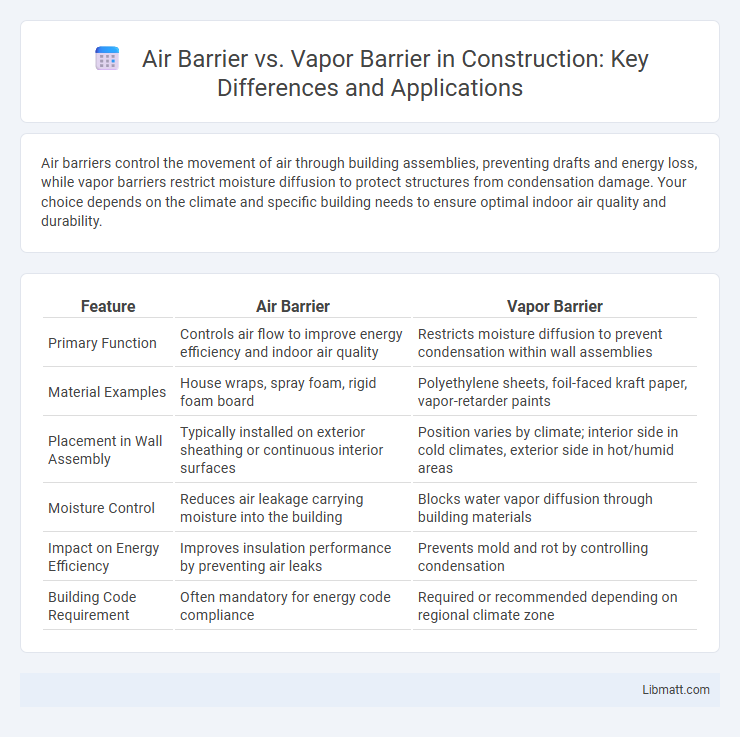Air barriers control the movement of air through building assemblies, preventing drafts and energy loss, while vapor barriers restrict moisture diffusion to protect structures from condensation damage. Your choice depends on the climate and specific building needs to ensure optimal indoor air quality and durability.
Table of Comparison
| Feature | Air Barrier | Vapor Barrier |
|---|---|---|
| Primary Function | Controls air flow to improve energy efficiency and indoor air quality | Restricts moisture diffusion to prevent condensation within wall assemblies |
| Material Examples | House wraps, spray foam, rigid foam board | Polyethylene sheets, foil-faced kraft paper, vapor-retarder paints |
| Placement in Wall Assembly | Typically installed on exterior sheathing or continuous interior surfaces | Position varies by climate; interior side in cold climates, exterior side in hot/humid areas |
| Moisture Control | Reduces air leakage carrying moisture into the building | Blocks water vapor diffusion through building materials |
| Impact on Energy Efficiency | Improves insulation performance by preventing air leaks | Prevents mold and rot by controlling condensation |
| Building Code Requirement | Often mandatory for energy code compliance | Required or recommended depending on regional climate zone |
Understanding Air Barriers and Vapor Barriers
Air barriers control the movement of air through walls, ceilings, and floors, preventing drafts and improving energy efficiency by reducing heat loss and moisture intrusion. Vapor barriers are materials designed to limit the diffusion of moisture vapor, protecting building assemblies from condensation and mold growth. Understanding the distinct functions of air barriers and vapor barriers is essential for proper building envelope design to ensure optimal indoor air quality and durability.
Key Differences Between Air Barriers and Vapor Barriers
Air barriers control the movement of air through building envelopes, preventing drafts and improving energy efficiency, while vapor barriers specifically limit moisture diffusion to protect structures from condensation damage. Air barriers are typically made from materials like house wraps or spray foam, designed to seal cracks and gaps, whereas vapor barriers use polyethylene sheets or foil to block water vapor transmission. Understanding these key differences helps you select the appropriate barrier to maintain indoor air quality and structural integrity in varying climate conditions.
Functions of Air Barriers in Building Envelopes
Air barriers in building envelopes control the movement of air, preventing drafts and improving energy efficiency by maintaining consistent indoor temperatures. They protect your building from moisture intrusion by reducing air leakage that can carry water vapor and pollutants into wall assemblies. Effective air barriers also enhance indoor air quality and help extend the durability of construction materials.
Role of Vapor Barriers in Moisture Control
Vapor barriers play a crucial role in moisture control by preventing water vapor from penetrating walls, ceilings, and floors, which can lead to mold growth and structural damage. Unlike air barriers that control air leakage, vapor barriers specifically reduce the diffusion of moisture through building assemblies. Proper installation of vapor barriers in climates with high humidity ensures indoor air quality and extends the durability of building materials.
Materials Commonly Used for Air and Vapor Barriers
Air barriers commonly utilize materials such as spray foam, polyethylene sheets, and self-adhered membranes like rubberized asphalt to prevent air infiltration. Vapor barriers often consist of polyethylene plastic sheeting, foil-faced kraft paper, and vapor-retarder paints designed to control moisture diffusion within building assemblies. Selecting appropriate materials depends on the climate, building design, and the specific location within the wall or roof assembly where moisture or air control is critical.
Where to Install Air Barriers and Vapor Barriers
Air barriers are installed on the exterior side of the insulation in walls, ceilings, and roofs to prevent uncontrolled airflow that can lead to energy loss and moisture problems. Vapor barriers are placed on the warm-in-winter side of insulation, typically inside the building envelope, to control moisture diffusion and prevent condensation within wall assemblies. Proper placement of air and vapor barriers according to climate and building design is critical to maintaining structural integrity and indoor air quality.
Climate Considerations for Barrier Selection
Choosing between an air barrier and a vapor barrier depends heavily on your local climate, as temperature and humidity levels influence moisture movement within building assemblies. In cold climates, vapor barriers are crucial to prevent moisture from migrating into wall cavities and freezing, causing condensation damage. Conversely, air barriers are essential in hot, humid climates to block warm, moist air infiltration that can lead to mold growth and structural deterioration.
Common Installation Mistakes and Solutions
Common installation mistakes for air barriers include gaps, improper sealing at joints, and failure to integrate with other building components, leading to air leakage and reduced energy efficiency. Vapor barriers are often incorrectly positioned or punctured during installation, causing moisture intrusion and potential mold growth. You can prevent these issues by thoroughly inspecting seams, using compatible materials, and ensuring continuous, airtight, and vapor-tight coverage based on specific climate conditions.
Energy Efficiency Impacts: Air vs. Vapor Barriers
Air barriers control the flow of air leakage, significantly reducing energy loss by preventing drafts and maintaining consistent indoor temperatures. Vapor barriers limit moisture diffusion through building materials, reducing the risk of condensation and mold but have less impact on direct energy savings compared to air barriers. Effective energy efficiency strategies prioritize airtight construction with proper air barriers to minimize heating and cooling loads, while vapor barriers enhance durability by managing moisture.
Choosing the Right Barrier for Your Project
Selecting the right barrier depends on your project's climate conditions and building materials, as air barriers control airflow while vapor barriers restrict moisture diffusion. Air barriers prevent energy loss and enhance indoor air quality by sealing gaps, whereas vapor barriers protect structural components from condensation and mold in humid environments. Understanding these distinctions ensures your building maintains durability, energy efficiency, and occupant comfort.
Air barrier vs Vapor barrier Infographic

 libmatt.com
libmatt.com